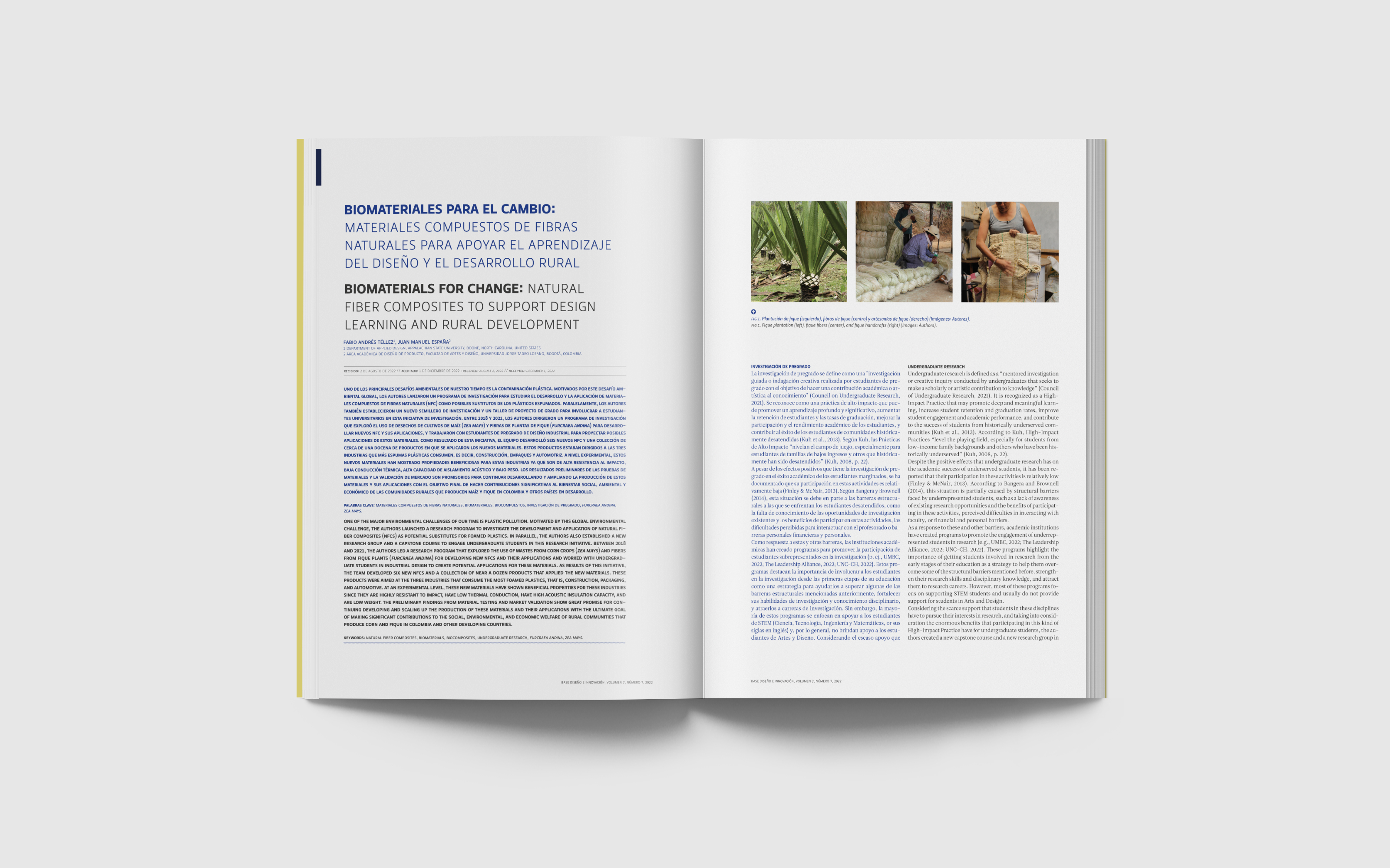Biomaterials for change Natural fiber composites to support design learning and rural development
Main Article Content
Abstract
One of the major environmental challenges of our time is plastic pollution. Motivated by this global environmental challenge, the authors launched a research program to investigate the development and application of natural fiber composites (NFCs) as potential substitutes for foamed plastics (e.g Styrofoam). In parallel, the authors also established a new research group and a capstone course in their industrial design program to engage undergraduate students in this research initiative. Between 2018 and 2021, the authors led a research program intended to explore the use of wastes from corn crops (Zea mays) and fibers from fique plants (Furcraea andina) for developing new NFCs and their applications. Throughout this program, the authors mentored five cohorts of undergraduate students in industrial design, who proposed and conducted their capstone projects in alignment with the program’s research agenda. This program was funded by internal grants and the investment of a private company interested in producing and commercializing some of the applications developed by the researchers. As results of this research initiative supported by undergraduate students, the research team developed a family of six new Natural Fiber Composites and a collection of near a dozen products that applied the new materials. These new products were aimed at the three industries that consume the most foamed plastics, that is, construction, packaging, and automotive. At an experimental level, these new materials have shown beneficial properties for these industries since they are highly resistant to impact, have low thermal conduction, have high acoustic insulation capacity, and have low weight. The preliminary findings from material testing and market validation show great promise for continuing developing and scaling up the production of these new NFCs and their applications with the ultimate goal of making significant contributions to the social, environmental, and economic welfare of rural communities that produce corn and fique in Colombia and other developing countries.
Article Details
References
Abdellaoui, H., Bensalah, H., Echaabi, J., Bouhfid, R., & Qaiss, A. (2015). Fabrication, characterization and modelling of laminated composites based on woven jute fibres reinforced epoxy resin. Materials and Design, 68, 104–113. https://doi.org/10.1016/j.matdes.2014.11.059
Addington, M., & Schodek, D. (2005). Smart Materials and New Technologies for the Architecture and Design Professions. Architectural Press.
Bangera, G., & Brownell, S. E. (2014). Course-based undergraduate research experiences can make scientific research more inclusive. CBE Life Sciences Education, 13(4), 602–606 https://doi.org/10.1187/cbe.14-06-0099
Council on Undergraduate Research (2021). Council on Undergraduate Research Issues Updated Definition of Undergraduate Research. Council of Undergraduate Research. https://www.cur.org/council_on_undergraduate_research_issues_updated_definition_of_undergraduate_research/
Crawford, C. B., & Quinn, B. (2016). Microplastic Pollutants. Elsevier Limited.
Design Council. (2007, January 20). 11 Lessons: A Study of the Design Process. https://www.designcouncil.org.uk/our-work/skills-learning/resources/11-lessons-managing-design-global-brands/
Finley, A., & McNair, T. (2013). Assessing Underserved Students’ Engagement in High-Impact Practices. Association of American Colleges and Universities.
Kuh, G. D. (2008). High-impact educational practices: what they are, who has access to them, and why they matter. Association of American Colleges and Universities.
Kuh, G. D., O’Donnell, K., & Reed, S. (2013). Ensuring Quality and Taking High-Impact Practices to Scale. Association of American Colleges and Universities.
Lebreton, L., Slat, B., Ferrari, F., Sainte-Rose, B., Aitken, J., Marthouse, R., Hajbane, S., Cunsolo, S., Schwarz, A., Levivier, A., Noble, K., Debeljak, P., Maral, H., Schoeneich-Argent, R., Brambini, R., & Reisser, J. (2018). Evidence that the Great Pacific Garbage Patch is rapidly accumulating plastic. Scientific Reports, 1–15. https://doi.org/10.1038/s41598-018-22939-w
Margeta, A., Šabalja, ?., & ?or?evi?, M. (2021). The presence and danger of microplastics in the oceans. Scientific Journal of Maritime Research, 35(2), 224–230. https://doi.org/10.31217/p.35.2.4
Mittal, M., Mittal, D., & Aggarwal, N. K. (2022). Plastic accumulation during COVID-19: call for another pandemic; bioplastic a step towards this challenge? Environmental Science and Pollution Research, 29(8), 11039–11053. https://doi.org/10.1007/s11356-021-17792-w
OECD. (2022). Global Plastics Outlook: Economic Drivers, Environmental Impacts and Policy Options. OECD Publishing. https://doi.org/10.1787/de747aef-en
Rhodes, C. J. (2019). Solving the plastic problem: From cradle to grave, to reincarnation. Science Progress, 102(3), 218–248. https://doi.org/10.1177/0036850419867204
Sahoo, P., Das, S. K., & Acharya, S. K. (2017). Tribological aspects of natural fiber composites. In P. J. Davim (Ed.), Green Composites (pp. 33–68). De Gruyter. https://doi.org/10.1515/9783110435788-003
The Leadership Alliance (2022). What We Do. The Leadership Alliance. https://theleadershipalliance.org/what-we-do
University of Maryland Baltimore County (2022). About the Meyerhoff Scholars Program. UMBC. https://meyerhoff.umbc.edu/
University of North Carolina at Chapel Hill (2022). About CSS. Chancellor’s Science Scholars Program, College of Arts and Sciences, UNC Chapel Hill. https://chancellorssciencescholars.unc.edu/about/
Wang, Y., Tong, B., Hou, S., Li, M., & Shen, C. (2011). Transcrystallization behavior at the poly(lactic acid)/sisal fibre biocomposite interface. Composites Part A, 42(1), 66-74. https://doi.org/10.1016/j.compositesa.2010.10.006
Zhou, Y., Fan, M., Chen, L., & Zhuang, J. (2015). Lignocellulosic fibre mediated rubber composites: An overview. Composites Part B: Engineering, 76, 180-191. https://doi.org/10.1016/j.compositesb.2015.02.028


